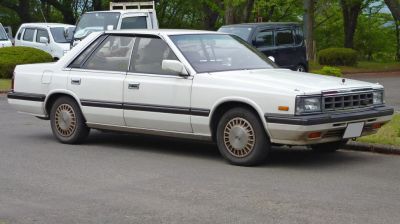 1975 Triumph 2500 Dimensions, Size & Specs
1975 Triumph 2500 Dimensions, Size & SpecsMeasurements of the 1975 Triumph 2500, engineered for optimal performance and comfort
| Dimensions | |
|---|---|
| Length: | 4655 mm183.3 in15.3 ft |
| Width: | 1712 mm67.4 in5.6 ft |
| Height: | 1435 mm56.5 in4.7 ft |
| Weight Specifications | |
| Curb Weight: | 1223 kg2696 lbs |
| Tire Specifications | |
| Rims Size: | 14-inch rims:
|
The Triumph 2500, produced between 1974 and 1977, represents a classic British sedan from the mid-1970s, known for its blend of performance and style. The 1975 model year features a well-proportioned body with a length of 4655 mm (approximately 183.3 inches), a width of 1712 mm (67.4 inches), and a height of 1435 mm (56.5 inches). This gives the car a balanced stance on the road, suitable for both urban and long-distance driving. Weighing in at 1223 kg (2697 lbs), the Triumph 2500 offers a relatively lightweight platform which enhances its driving dynamics and fuel efficiency compared to heavier sedans of its era.
The sedan configuration of the Triumph 2500 provides ample interior space for passengers, complemented by the car's modest footprint which eases maneuverability. Equipped with 14-inch rims sized 5.5J x 14, the car combines classic styling with adequate road grip. During its production years, the Triumph 2500 was appreciated for its smooth ride and solid build quality, representing British automotive craftsmanship of the 1970s.
In the context of classic car size comparisons, the Triumph 2500 holds a distinctive place with dimensions that strike a good balance between spaciousness and compactness. It appeals to enthusiasts who favor traditional British sedans that are not overly large yet comfortable. Whether for collectors or classic car fans, the Triumph 2500 stands out as a symbol of its time with practical dimensions and elegant design.
Discover the standout features that make the 1975 Triumph 2500 a leader in its class
Have a question? Please check our knowledgebase first.
The Triumph 2500 sedan, produced between 1974 and 1977, has an overall length of 4655 mm (183.3 inches). During the 1970s, sedans often ranged between 4.2 meters to 4.8 meters in length, positioning the Triumph 2500 squarely in the mid-to-upper range of midsize sedans of its era. The length contributed to a relatively spacious interior with decent legroom for passengers in both front and rear seats. Its size was practical for urban and suburban driving while still offering a comfortable ride for longer journeys.
The width of the Triumph 2500 is 1712 mm (approximately 67.4 inches). This width is typical for sedans from the 1970s and provides a balanced interior cabin space that comfortably accommodates front and rear passengers side-by-side. From a handling perspective, this width gives the vehicle stable road manners without being overly wide, which helps the car maneuver through narrower streets and tight parking spaces more effectively. Overall, it offers a good compromise between interior comfort and driving agility.
The Triumph 2500 sedan stands at a height of 1435 mm (56.5 inches). This moderate height delivers adequate headroom for most passengers, contributing to a comfortable seating position without making the car feel bulky. The relatively low profile gives the car a sporty and sleek appearance, which also helps in maintaining good aerodynamic properties. In terms of visibility, the height allows for a balanced vantage point for the driver, combining clear forward and peripheral views while reducing blind spots typical in taller vehicles.
The Triumph 2500 weighs approximately 1223 kg (about 2697 pounds) in curb weight. This relatively lightweight for a mid-1970s sedan benefits both performance and fuel efficiency. A lower curb weight generally helps improve acceleration, handling agility, and braking responsiveness. It also contributes to more efficient fuel consumption since less mass requires less energy to move. When combined with the engine choices of that period, the Triumph 2500 was able to deliver a satisfying balance of spirited driving dynamics and reasonable economy.
The Triumph 2500 is equipped with 5.5J x 14 inch rims, which were common for vehicles of its size and production period. These 14-inch wheels provide a good balance between ride comfort and handling performance. Smaller rims with higher-profile tires typically absorb road irregularities better, enhancing comfort, while still providing enough sidewall to maintain tire integrity during cornering. This rim size allowed the Triumph 2500 to offer a smooth ride quality suitable for both city commuting and longer trips.
The Triumph 2500, with a length of 4655 mm (183.3 inches), a width of 1712 mm (67.4 inches), and a height of 1435 mm (56.5 inches), fits comfortably within the dimensions of a standard home garage. Most single-car garages typically have an interior length of about 5.5 to 6 meters (18 to 20 feet) and a width of around 2.5 to 3 meters (8 to 10 feet), providing ample room for the vehicle with additional space for maneuvering and storage. Owners will find that the Triumph 2500 does not require any special accommodations and can be parked indoors with ease, protecting it from weather elements.
Compared to its direct predecessor, the Triumph 2000, the Triumph 2500 maintains very similar external dimensions but typically features minor increases in length and curb weight due to mechanical upgrades and additional equipment. The 2000 was slightly shorter and somewhat lighter, making the 2500 a bit more substantial on the road. These changes aimed to improve interior space, ride comfort, and overall build quality. However, the differences are subtle enough that both cars share comparable driving dynamics and parking ease.
In comparison to similar mid-1970s executive sedans, such as the Ford Cortina Mk3 or the Austin Princess, the Triumph 2500 is broadly competitive in size and weight. At 4655 mm in length, it is slightly longer than the Cortina but close in size to other contemporaries like the Austin Princess. The curb weight of 1223 kg (2697 lbs) positions it as moderately light, enhancing agility relative to heavier executive sedans. This balance of size and weight allowed the Triumph 2500 to compete effectively in its class by offering both driving comfort and adequate interior space.
The Triumph 2500 was designed with passenger comfort in mind, boasting a roomy interior that accommodated up to five passengers comfortably. Its overall length and width provide ample legroom and shoulder space, especially in the front seats. The height of the cabin allows for sufficient headroom without compromising the car's sleek design. Interior appointments typically included supportive seats with quality materials for the time, and the suspension system was tuned to optimize comfort on varying road surfaces. All these features combined to offer a refined driving and riding experience typical of an executive-class sedan from the mid-1970s.
During its production from 1974 to 1977, the Triumph 2500 was equipped with a robust inline six-cylinder engine, which provided smooth and reliable power delivery suitable for an executive sedan. The suspension setup generally combined coil springs and wishbones, contributing to responsive handling and ride comfort. Braking systems included front disc brakes, an advancement that enhanced safety and control. This generation of the Triumph 2500 was known for blending performance with comfort, making it a popular choice for those seeking a capable yet refined driving experience in a mid-size sedan.
Discover similar sized cars.

| Production: | 1985-1987 |
|---|---|
| Model Year: | 1985 |
| Length: | 4650 mm183.1 in |
| Width: | 1690 mm66.5 in |
| Height: | 1425 mm56.1 in |

| Production: | 2018-present |
|---|---|
| Model Year: | 2018 |
| Length: | 4677 mm184.1 in |
| Width: | 1760 mm69.3 in |
| Height: | 1520 mm59.8 in |

| Production: | 2024-present |
|---|---|
| Model Year: | 2025 |
| Length: | 4690 mm184.6 in |
| Width: | 1764 mm69.4 in |
| Height: | 1505 mm59.3 in |
